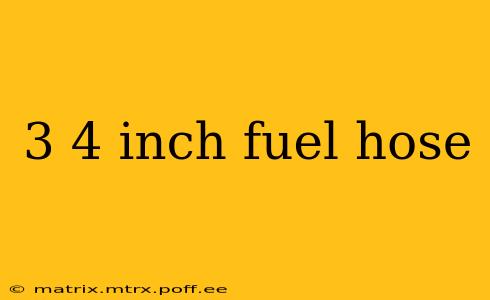3/4 Inch Fuel Hose: A Comprehensive Guide
Finding the right fuel hose is crucial for ensuring the safe and efficient operation of any gasoline-powered equipment. A 3/4 inch fuel hose is a common size used in various applications, from lawnmowers and generators to automobiles and boats. Choosing the correct hose requires understanding its specifications, materials, and applications. This guide will delve into everything you need to know about 3/4 inch fuel hoses.
What is a 3/4 Inch Fuel Hose Used For?
A 3/4 inch fuel hose, as its name suggests, has an inner diameter of 3/4 inch. This size is suitable for a wide array of applications where fuel transfer is required. Common uses include:
- Small Engines: Lawnmowers, generators, pressure washers, and other small gasoline-powered equipment often utilize 3/4 inch fuel lines.
- Automotive Applications: While larger hoses are common in main fuel lines, 3/4 inch hose might be used in specific automotive applications or for fuel transfer between containers.
- Marine Applications: Smaller boats and outboards may utilize this size hose for fuel delivery.
- Fuel Transfer: Transferring gasoline from one container to another safely.
Important Note: Always consult your equipment's manual to confirm the correct hose size and specifications before purchasing.
What Materials are 3/4 Inch Fuel Hoses Made Of?
The material of a fuel hose is critical to its performance and safety. Several materials are commonly used, each with its advantages and disadvantages:
- Rubber: A common and relatively inexpensive choice, rubber hoses offer good flexibility but can be prone to cracking and degradation over time, especially with exposure to sunlight and extreme temperatures.
- EPDM Rubber: Ethylene Propylene Diene Monomer (EPDM) rubber is a more durable and resistant type of rubber, offering better resistance to chemicals, ozone, and weathering. This makes it a more suitable choice for long-term outdoor use.
- Nitrile Rubber (NBR): Known for its excellent resistance to oil and fuel, Nitrile rubber is a great option for applications involving gasoline and other petroleum-based fuels. However, it might be less flexible than other options.
- Reinforced Hoses: Many 3/4 inch fuel hoses include a reinforcement layer, often made of fabric or wire mesh. This reinforcement adds strength and prevents the hose from collapsing under pressure.
Choosing the right material depends on the specific application and the operating conditions.
What are the Different Types of 3/4 Inch Fuel Hose Fittings?
The fittings on a fuel hose are equally important. These fittings connect the hose to fuel tanks, pumps, and other components. Common fittings include:
- Barb Fittings: These fittings feature barbs that grip the hose, creating a secure connection. They are often used with clamps to ensure a leak-proof seal.
- Clamp Fittings: These require separate hose clamps to secure the hose to the fitting.
- Quick Disconnect Fittings: These allow for quick and easy connection and disconnection of the hose.
How to Choose the Right 3/4 Inch Fuel Hose?
Selecting the appropriate 3/4 inch fuel hose depends on several factors:
- Application: The intended use dictates the necessary durability, flexibility, and chemical resistance.
- Fuel Type: Ensure the hose is compatible with the type of fuel it will handle.
- Pressure Rating: The hose must be able to withstand the pressure of the fuel system. Check the hose's working pressure rating and ensure it exceeds the system's maximum pressure.
- Temperature Range: Consider the temperature range the hose will be exposed to. Choose a hose with a temperature rating that covers the expected operating conditions.
- Length: Choose a hose of sufficient length for the application.
How Long Does a 3/4 Inch Fuel Hose Last?
The lifespan of a 3/4 inch fuel hose depends on several factors including the quality of the hose, the materials used, and the operating conditions. A high-quality hose, properly maintained and used within its operating parameters, can last for several years. However, regular inspection is vital to identify any signs of wear, cracking, or damage. Replacing a damaged hose immediately is crucial for safety.
What are the Safety Precautions When Using a 3/4 Inch Fuel Hose?
- Always use the correct hose size and type for the application.
- Inspect the hose regularly for any signs of damage.
- Replace any damaged hose immediately.
- Never use a fuel hose that is cracked, brittle, or leaking.
- Handle gasoline carefully and avoid spills.
- Work in a well-ventilated area.
- Always follow the manufacturer's instructions.
This comprehensive guide aims to provide a thorough understanding of 3/4 inch fuel hoses. Remember, choosing the right hose is critical for safety and proper equipment functionality. Always prioritize safety and follow the recommended guidelines for handling fuel and fuel lines.
